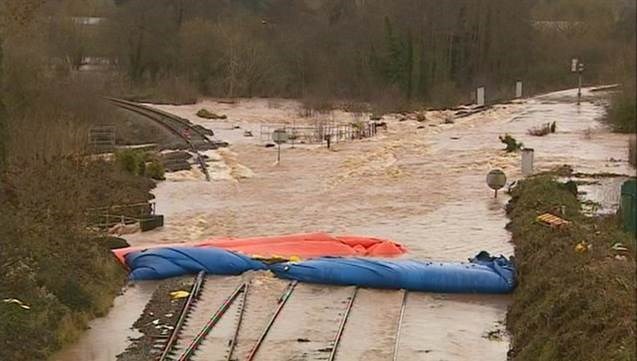Monday 20 Oct 2014
Proposed solution to flooding at Cowley and Stafford bridges in Exeter
- Region & Route:
- | Wales & Western: Western
- | Wales & Western
Network Rail has today announced its preferred solution for tackling the problem of continual flooding at Cowley and Stafford bridges in Exeter. This solution involves the removal of three weirs close to the bridges to lower the water level in this part of the River Exe.
Flooding at these bridges is a long-standing problem that has had a devastating impact on the nearby railway line and on the local community. In total, it has resulted in four weeks of disruption over the last two years, meaning numerous delays and closures on this part of the Great Western Main Line; loss of profit for businesses in the area; and a huge inconvenience to local residents.
Over the last year, Network Rail has been working to find a long-term solution to these problems. This has involved undertaking an in-depth environmental study of the area to establish the cause of the flooding and an assessment of the options available to reduce the chances of it happening again.
The solution of removing Pynes, Exwick and Cowley weirs was chosen as the most preferable because it would provide the highest return on investment when the extent to which it could prevent further flooding was compared to its cost. Once the three weirs are removed, the river will be returned to its natural state, meaning that in this part the water level will fall by up to a metre.
Joanna Grew, Network Rail’s commercial scheme sponsor for the project, said: “Over the years, flooding at these two bridges has caused huge disruption on the Great Western Main Line, severely inconveniencing passengers and harming the region’s economy. As a good neighbour, we are also aware of the extensive problems it causes the local community, which is why we have been working to find a long-term solution.
“The preferred option of removing the weirs is the most favourable as it would not only limit the chances of flooding in the future, it is also the option that provides good value for money for the public.
“We are now working with the council and other stakeholders to gather their views on our proposal and will keep the local community updated on our progress.”
George Arnison, from the Environment Agency, said: “We are pleased to support Network Rail’s work to improve the railway’s resilience to flooding.
"It’s great to see a solution emerge that complements the Exeter Flood Defence Scheme proposals and seems to offer both flood risk and environmental benefits.”
Contact information
Passengers / community members
Network Rail national helpline
03457 11 41 41
Latest travel advice
Please visit National Rail Enquiries
Journalists
Network Rail press office -Western route
MediaRelationsWestern@networkrail.co.uk
About Network Rail
We own, operate and develop Britain's railway infrastructure; that's 20,000 miles of track, 30,000 bridges, tunnels and viaducts and the thousands of signals, level crossings and stations. We run 20 of the UK's largest stations while all the others, over 2,500, are run by the country's train operating companies.
Usually, there are almost five million journeys made in the UK and over 600 freight trains run on the network. People depend on Britain's railway for their daily commute, to visit friends and loved ones and to get them home safe every day. Our role is to deliver a safe and reliable railway, so we carefully manage and deliver thousands of projects every year that form part of the multi-billion pound Railway Upgrade Plan, to grow and expand the nation's railway network to respond to the tremendous growth and demand the railway has experienced - a doubling of passenger journeys over the past 20 years.
Follow us on Twitter: @networkrail
Visit our online newsroom: www.networkrailmediacentre.co.uk

